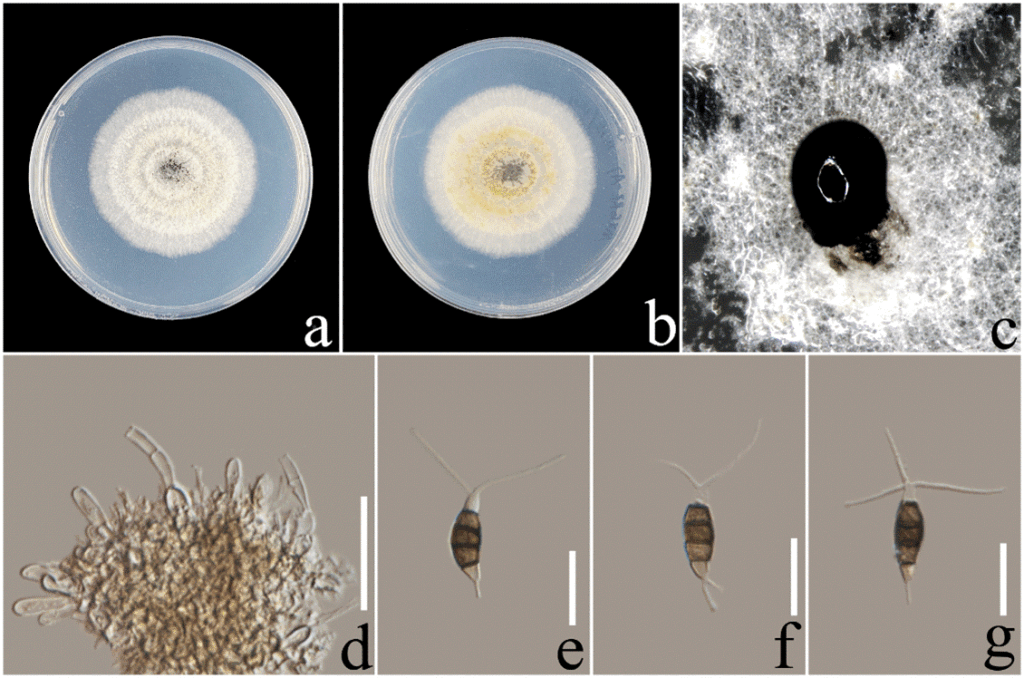Pestalotiopsis sabal Y.R. Xiong, Manawas., & K.D. Hyde, in Xiong, Manawas, Maharachchikumbura, Lu, Dong, Xiang & Xu, Curr. Res. Envir. & App. Myc. 12(1): 312 (2022)
Index Fungorum number: IF 559618; MycoBank number: MB 559618; Facesoffungi number: FoF 10806;
Etymology – Epithet refers to the host genus from which the fungus was isolated.
Type – ZHKU 22–0035
Pathogenic on Sabal mexicana lamina. Sexual morph: not observed. Asexual morph: Conidiomata 490–560 µm diam, pycnidial (on PDA), globose to clavate, solitary or aggregate, black, semi-immersed, ostiole in the center; releasing conidia in a black, slimy, globose, glistening mass. Conidiophores reduce to conidiogenous cells, smooth, hyaline. Conidiogenous cell 4.5 × 3 µm, discrete, smooth-walled, hyaline, subcylindrical. Conidia 17.5–23 × 5.5–7 µm (x̄± SD = 20 ± 1.7 × 6.5 ± 0.6 µm, n = 40), fusiform to ellipsoid, 4-septate, slightly constricted at septa, straight to slight curved; basal cell 3–5.5 µm long, conic with a truncate base, hyaline, sparsely verruculose and thin- or smooth-walled; three median cells 11–14 µm long, x̄ ± SD = 12 ± 1 µm, doliiform, sparsely verruculose, versicolored, olivaceous, septa darker than the rest of the cell (second cell from the base 3–5 µm; third cell 3.5–5 µm; fourth cell 3.5–5 µm); apical cell 3–5 µm long, hyaline, sparsely verruculose, conical to subcylindrical, smooth-walled; apical appendages 7–20 µm long, x̄ ± SD = 14 ± 3.4 µm, 1–3 (seldom 1), tubular, arising from the apical crest, unbranched, filiform; basal appendage 3–6 µm long, 1–2, tubular, unbranched, centric.
Culture characteristics – Colonies on PDA attaining 5 cm diam after 7 d at 25 ℃, circular, rugose, curled, rotiform, rough, forming abundant pycnidia near the center, white, undulate; reverse buff to cream.
Habitat and distribution – widespread in tropical and subtropical regions
Material examined – CHINA, Guangdong Province, Guangzhou City, South China Botanical Garden, symptomatic lamina of Sabal mexicana, 17 June 2020, Y.R. Xiong (ZHKU 22–0035, holotype as dry culture; ex-type living culture, ZHKUCC 22–0026). Additional herbarium materials ZHKU 22–0019 to ZHKU 22–0028 (dry cultures); living cultures ZHKUCC 22–0027, ZHKUCC 22–0028, ZHKUCC 22–0029, ZHKUCC 22–0030, ZHKUCC 22–0031, ZHKUCC 22–0032, ZHKUCC 22–0033, ZHKUCC 22–0034, ZHKUCC 22–0036 and ZHKUCC 22–0037.
Notes – The eleven isolates obtained in this study developed an independent clade in Pestalotiopsis phylogenetic tree with low statistical support (Fig 3). Pestalotiopsis sabal is phylogenetically separated from P. thailandica and P. rhizophorae (Fig 3). Further confirmation with PHI analysis showed that there is no evidence of significant genetic recombination (Fw=0.616) between our species and its closely related species. The number of apical appendages of P. sabal is 1–3, while the number of sister clade P. thailandica is 1–2, and the size of basal cells is also different (Table 3). Combining both phylogenic evidence and morphology P. sabal was identified as a new species.

Figure 10. Pestalotiopsis sabal (ZHKU 22–0035). (a) The front view of a two-week-old colony on PDA; (b) The reverse view of a two-week-old colony on PDA; (c) Pycnidium; (d) Conidiogenous cells giving rise to conidia; (e–g) Conidia. Scale bars: d = 30 µm; e–g = 15 µm.
